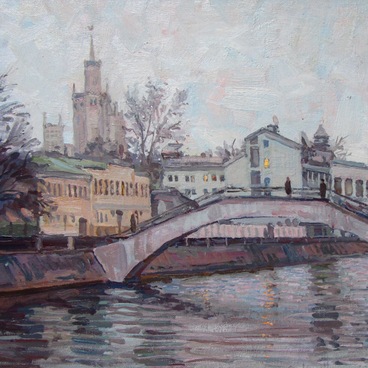The painting “Prayer (Dhikr)” is displayed in the museum. Famous artist Lemi Abaev created it in the Expressionist genre. Hazelnut branches are depicted in the foreground. They frame the painting and focus the viewer’s attention on the scene in the center of the canvas.
The painting depicts six Murids, followers of Muridism, an Islamic religious movement. They perform a dhikr — a religious ceremony. During the dhikr, the believers form a circle and walk back and forth singing religious chants. Sometimes when the most authoritative participant gives a certain sign, they start walking faster. The ritual is one way of worshipping Allah Almighty. At that moment, a Muslim must be completely immersed in what is going on and forget earthly duties.
In the left corner, the artist depicted two staffs hanging from a tree. It is a traditional attribute of elderly people in the Chechen Republic: also, a walking stick is considered a sacred item by the Murids. Traditionally, a man with a white beard and a staff was respected by everyone around him because of his great life experience and wisdom. He was held in great honor, and regardless of age, the other people had to stand up in his presence. The Head of the Chechen Republic keeps the staff of the 19th–century preacher and revered sheikh Kunta-haji Kishiev as a holy relic.
Artist Lemi Abaev was born in 1961. He graduated from the Faculty of Painting of the Ilya Repin Academy of Arts in St. Petersburg. The artist presented the canvas “February 1944” as his graduation work and got an “excellent” grade. After graduating from the university, Abaev was a qualified painter and teacher.
The painting depicts six Murids, followers of Muridism, an Islamic religious movement. They perform a dhikr — a religious ceremony. During the dhikr, the believers form a circle and walk back and forth singing religious chants. Sometimes when the most authoritative participant gives a certain sign, they start walking faster. The ritual is one way of worshipping Allah Almighty. At that moment, a Muslim must be completely immersed in what is going on and forget earthly duties.
Abaev depicted five men in papakhas — tall hats made of karakul sheep skin, that since olden times have been worn in the Chechen Republic. One other person wears a traditional tubeteika, a skullcap. The artist only partially painted the figures of the men in detail: they merge into one homogeneous orange color. Thus, Abaev emphasized the unity of those involved in the dhikr. According to the rules, the worshippers perform the ritual barefoot. This is a sign of love for their native land, with which the Chechens were long separated after they were exiled to Central Asia and Kazakhstan in the 20th century.
In the left corner, the artist depicted two staffs hanging from a tree. It is a traditional attribute of elderly people in the Chechen Republic: also, a walking stick is considered a sacred item by the Murids. Traditionally, a man with a white beard and a staff was respected by everyone around him because of his great life experience and wisdom. He was held in great honor, and regardless of age, the other people had to stand up in his presence. The Head of the Chechen Republic keeps the staff of the 19th–century preacher and revered sheikh Kunta-haji Kishiev as a holy relic.
Artist Lemi Abaev was born in 1961. He graduated from the Faculty of Painting of the Ilya Repin Academy of Arts in St. Petersburg. The artist presented the canvas “February 1944” as his graduation work and got an “excellent” grade. After graduating from the university, Abaev was a qualified painter and teacher.



